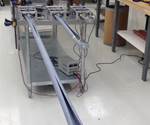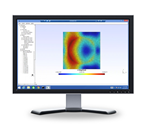AnalySwift receives NASA grant to improve design of composite deployable structures
The $125,000 grant will further development of SwiftComp software to improve modeling and design for deployable structures built from high-strain composites.

This image shows some of the high-strain composite deployable booms under development at NASA Langley Research Center. Source | NASA, via Purdue University
AnalySwift LLC (West Jordan, Utah, U.S.), a Purdue University-affiliated commercial software provider, announced on Jan. 21 that it has received a $125,000 Small Business Technology Transfer (STTR) grant from NASA to further develop of its SwiftComp software, technology that provides efficient, high-fidelity modeling of deployable structures made of high-strain composites.
According to Allan Wood, president and CEO of AnalySwift, the software would help NASA engineers model high-strain composites with a tradeoff between efficiency and accuracy that were unreachable using more conventional methods. Wood says that NASA is looking to use the software technology, in part, to study deployables made of high-strain composites that are lightweight and feature time- and temperature-dependent behavior.
In addition to deployable composite booms, NASA could leverage the software for structures such as living vessels, foldable panels, hinges and reflectors, as well as lightweight structures such as satellite buses, landers, rovers, solar arrays and antennas, according to AnalySwift. Other applications include highly flexible wings for future aircraft and highly fatigue- and damage-tolerant structures for vertical lift aircraft.
In a program launched in early 2019, the software also has been licensed to companies and universities worldwide, including those using it for work on satellites and mobile phone components such as printed circuit boards.
SwiftComp technology was developed by Wenbin Yu, a professor of aeronautics and astronautics in Purdue’s College of Engineering. AnalySwift licensed the technology from the Purdue Research Foundation Office of Technology Commercialization.
“The unique synergistic relationship between Yu’s computational mechanics research group at Purdue and AnalySwift, with its SwiftComp simulation software, makes it a very efficient transition mechanism of new material and structures fundamental theory developments into the commercial world,” says Juan Fernandez, a research aerospace engineer with NASA. “The ultimate goal is to increase the capabilities of this commercial computational tool so that others in the high-strain composites community can benefit from it and help advance the field, while using it to satisfy current and future NASA program modeling needs.”
“This project will help expand the application of SwiftComp to composite structures and materials used in space environments featuring temperature- and time-dependent behavior,” Yu says.
Related Content
-
Materials & Processes: Composites fibers and resins
Compared to legacy materials like steel, aluminum, iron and titanium, composites are still coming of age, and only just now are being better understood by design and manufacturing engineers. However, composites’ physical properties — combined with unbeatable light weight — make them undeniably attractive.
-
Materials & Processes: Fibers for composites
The structural properties of composite materials are derived primarily from the fiber reinforcement. Fiber types, their manufacture, their uses and the end-market applications in which they find most use are described.
-
The state of recycled carbon fiber
As the need for carbon fiber rises, can recycling fill the gap?

.jpg;width=70;height=70;mode=crop)














